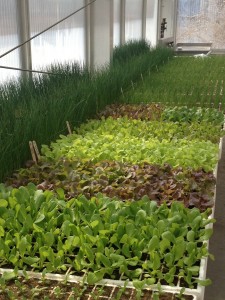On Monday, before the big rain and wind, we transplanted out our first round of lettuce, scallions and spring bunching leeks. Leeks can withstand the cold, but lettuce and scallions are more sensitive.

Plastic coverings keep our crops from freezing
On Tuesday morning, when it was less windy, we placed metal hoops over the beds of lettuce and scallions and then secured row cover over the beds. The hoops keep the row cover suspended over the crops so that when frost settles on the cover, it’s not touching the leaves of the plants. We took most of the curve out of the hoops so that they were shaped like long staples—rectangular rather than arced. This is so that the row cover would have a lower profile in the heavy wind. The row cover held in place through two nights of strong winds, and the plants look happy under there after Wednesday night’s hard frost—the soil in the open fields was pretty well frozen Thursday morning.
We will seed our third round of greens today, and will then have four large pieces of row cover to inspect each day. At this point—the third week of greens seeding—we need to start controlling weeds in the first planting. This requires uncovering those first beds, hoeing quickly, and then replacing the cover. After that hoeing, the first harvest of arugula and Asian greens will not be far off.

Leafy lettuce is sprouting in bright colors, and the onion shoots (back) are well on their way.
Lots of plants are out on the cold frame now—beets, flowers, onions, main-season leeks, bok choi, and kohlrabi. Soon we’ll move out the first cabbage, broccoli and cauliflower, and the second planting of head lettuce. On mild nights, we leave the plants uncovered. On cooler nights, we cover them with row cover. And on a night like Wednesday, we cover the plants with both row cover and plastic.
In the greenhouse, we’re transplanting peppers from their crowded germination trays to deep six-packs, where they’ll remain until we plant them into the fields in late May or the first week of June. We are also seeding our first succession of tomatoes! And we’re giving haircuts to our onions before we move them out onto the cold frame. Trimming the onions is thought to encourage bulbing, and it makes the plants much easier to handle come transplanting time—they will be wiry and stocky rather than floppy.

